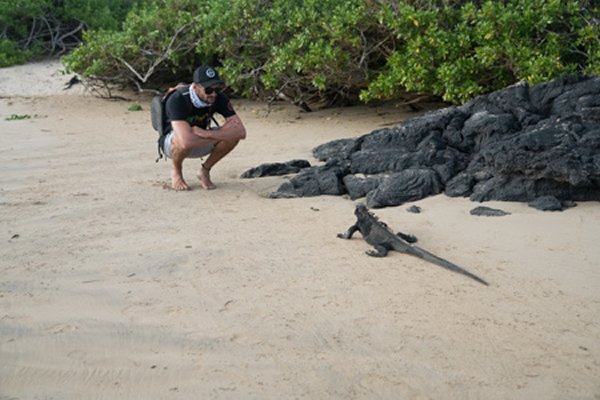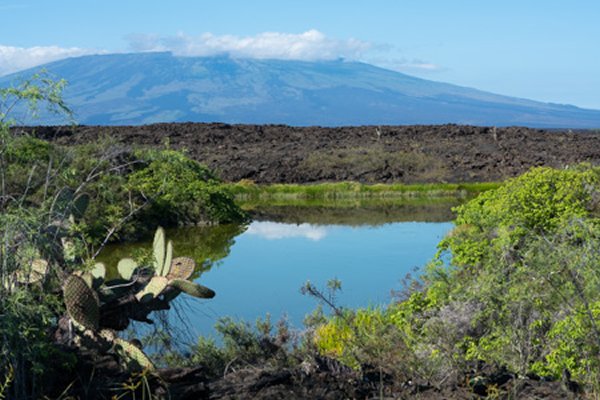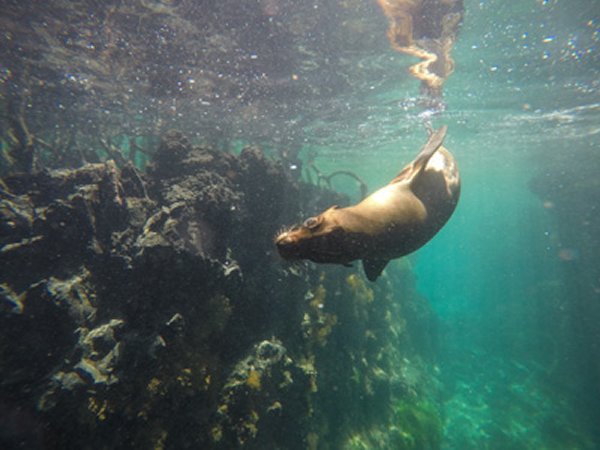Treasure of Galapagos 00:46S 090:18W

Seaflute
Sun 16 Apr 2017 23:10
we crossed the equator, we arrived in the early morning of the 28th March at
San Cristobal, the most easterly island in the Galapagos, where we were to
clear in and have the boat inspected. Sea Flute had been cleaned and
scrubbed inside and out, and any restricted foods had been duly eaten or
thrown away before we arrived there. We had been told how strict the
authorities were about this, so were feeling quite nervous about the
inspection. The Galapagans are very proud and fiercely protective of these
special islands and justly so, but we needn't have worried, as although nine
people came on board, most of them were there to complete the numerous forms
that we were required to have. What I found particularly odd, was that they
checked how many flares and fire extinguishers we had and if they were in
date! Anyway, after an hour, having had a cursory look around the boat and
in the freezer, we were told that our Zarpe (From the Spanish, Zarpar; to
set sail, to embark) would be issued. They can obviously tell when checking
out visiting boats, which ones are likely to give them a problem, they would
then act accordingly. Relieved, we were then quite keen to get away as soon
as possible as we needed to sail to another island, Santa Cruz, to collect
Jack from the airport the next morning. Unfortunately we then had to wait
another two hours for the Zarpe to be issued, which, when it arrived, was
hand delivered by water taxi!
Apart from the fact that there was no wind whatsoever and that we had to
motor, the crossing to Santa Cruz was spectacular! The sea was so calm and
flat it resembled a looking glass, with the sky, eerily reflected in its
surface, the only ripples were those of our making or from the many turtles,
rays and dolphins that came to play in our bow wave. None of us had ever
seen anything of the like, even our two experienced sailors.
Having read in our guide to 'Panama and the Galapagos' that the anchorages
here can be very 'rolly' we quickly found out that they weren't joking. The
crossing had been so smooth and serene, like skating on ice, then suddenly
after entering the bay of Santa Cruz, we were bouncing around like a cork!
What makes it so are the numerous water taxis and pangas (inflatable
tenders) from the cruise vessels, charging around at a hundred miles an hour
with no concern for the carnage left in their wake. I was quite concerned
how Jack would feel when he arrived on the boat, as he suffers from sea
sickness, but he seemed to cope with it, even if he did have to pop some
pills, or hail a water taxi to town now and again. Thankfully everything
quietens down at night so we could get to sleep with no problem.
A few days later we were to leave Santa Cruz on a large catamaran, 'Treasure
of Galapagos' for a week's cruise around the islands. We visited Isabela,
the largest of them all, and shaped like a sea horse. Santiago, Rabida and
Baltra. Each one uniquely different from the last, due to the volcanic
activity of the region. Their inhabitants, mostly reptiles, with the same
species also having evolved differently to each other due to their own
island habitats. Wet landings or dry landings, the days began early, often
with a nature walk at six or seven o'clock, with information regarding the
geological landscape and the flora and fauna from our naturalist Nick, then
back to the boat for breakfast or to change for a snorkelling trip before
lunch. This routine was often repeated in the afternoons so we were kept
extremely busy, although we did have times to ourselves where we were able
to catch up on sleep in my case, or spend time dolphin and whale spotting up
on deck. The boat usually moved from island to island during the night while
we slept, so each morning gave us a new view from our balconies. The
wildlife here is abundant and unique, with the birds and animals having no
fear of us. The Giant tortoise are just that, Sea lions came to play while
we snorkelled and birds carried on their daily business while we watched,
sometimes only inches away! The Equatorial penguins so small, look out of
place in the heat and so ungainly until they dive into the water and speed
by like rockets. Turtles, sharks, rays and marine iguanas entertained us on
our daily snorkels, aside from the myriad of fish, so much to see.
For those interested, a little information about the Galapagos islands
which are very young in age compared to the rest of the planet. The newer,
smaller islands continue to grow in size, while the larger of them are
gradually sinking back into the ocean from where they came, as they continue
their slow migration to the south east. The Galapagos are an archipelago of
volcanic islands consisting of eighteen main islands, but in fact there are
twenty one in total. It is rightly so, a Unesco world heritage site that
spans the equator, with a population today of just over twenty five thousand
inhabitants. The name Galapagos means saddle, given to them after the shape
of the shell of a particular group of giant tortoise.
These incredible Islands were discovered by accident in 1535 by Father Tomas
De Berlanga, the bishop of Panama whose ship was driven off course by strong
currents. In his memoirs he described the harsh landscapes, the giant
tortoise, marine iguanas, sea lions and the many sea birds. It wasn't until
1835, that Charles Darwin arrived there and began to collect his biological
and geological specimens. He published his book on the origin of species in
1859, a work that changed the way we look at, and understand the natural
world.
Unfortunately all good things come to an end and we had to return to Sea
Flute, where Rachael had been boat sitting for us. We discovered that only
two days into our cruise, the generator had sprung a leak. Fortunately
Rachael was able to contact the other Oyster owners and their crews, and
they came to her rescue. Well done Rachael for nursing the generator until
our return, when Dave was able to take the offending part to the local
mechanic for soldering. I am happy to report that the generator is running
like a dream. Even so, a replacement heat exchanger unit is on order!
Tom celebrated his birthday while we were there so we were keen to give him
a memorable day. A two dive trip to Gordons rock, on the east coast of Santa
Cruz, was booked for his special day. Another early start, a forty five
minute taxi ride to the boat, then a bumpy hour to the dive site. We were
told that the currents here were quite strong, so stay together. They were
right, they don't call this area the washing machine for nothing! By the end
of each dive I was absolutely exhausted, at one stage I was clinging to the
rocks, slowly dragging myself along like a crab! But what I will always
remember with absolute delight, besides more turtles, rays and sea lions
than you could shake a stick at, was having two large hammerhead sharks
circle Dave and I, and seeing a group of about forty of them swimming just
below us, amazing!
The day came for Jack to leave us and begin his long journey home. Forty
five minute taxi ride to the ferry, which takes you across a small channel
to Baltra Island, then a fifteen minute bus ride to the terminal. Two flight
changes and numerous hours later he would be home. We said our goodbyes, me
being my usual self, having a little weep. We watched him go through the
departure gate and Dave and I retraced our steps back to the bus, where we
were informed that they would not leave for the ferry until the next plane
arrived, in two hours! What about a taxi? We enquired, No taxis on Baltra.
With the scorching heat and exposed roads, walking was out of the question.
We sat down to wait. When eventually the plane arrived and the buses were
finally full of passengers, we began our fifteen minute drive back to the
ferry. Half way there the bus blew a tyre so we had to get off, only to
watch the second one thunder past us. Half an hour later it returned and we
were duly dropped off at the ferry dock. On the other side there are usually
about fifty taxis waiting, today there were none, only two battered old
buses, well it was Good Friday and everyone had gone home! We climbed aboard
hoping this one would make it back to the port. The forty five minute trip
took us an hour and a quarter but, just as we came to the outskirts of the
town a religious procession turned into the road in front of us. Again we
sat and waited as we were driven, at walking pace behind the statue of Jesus
being carried aloft for all to see. Fortunately our driver knew another
route into town. I have never been 'off roading' on a bus before, it
certainly made for an exciting ride!
That evening we met with many of the other owners for our farewell dinner,
as the next morning, many of us would be setting off on our three thousand
mile crossing to our next adventure in the Marquesas!
We were extremely sad to be leaving this amazing place, but the Galapagos,
as if it hadn't already blown our minds, sent a pod of forty or so pilot
whales and five sperm wales to keep us company for part of our journey. They
came right up to the boat riding on our stern wave, and were all around us,
we didn't know where to look. We were like a gaggle of school kids whooping
and laughing in our excitement! Luckily Tom managed to get some great
footage on our drone of the sperm wales, and photographs of the pilot whales
right next to the boat, he even got into the water with them! What an
extraordinary privilege, the only way I can describe it, using a word that
is horribly misused is, AWSOME!
We are still sailing as I am writing this and we should be in the Marquesas
around my birthday, on the eighth of May. Hopefully we will have more
exciting news of our cherished first Grandson, when we get there.
Take care all
Much love
Lindy xx









